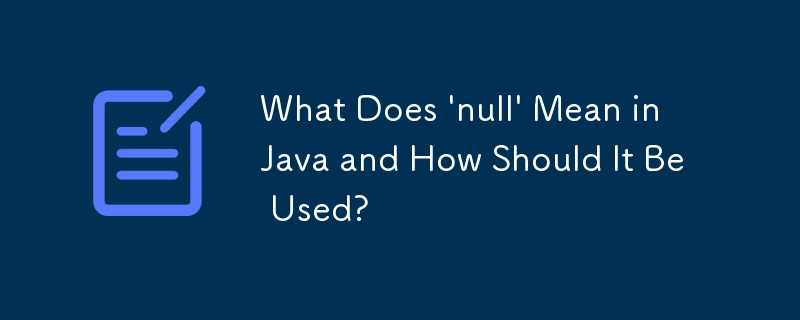What Does 'null' Mean in Java and How Should It Be Used?

Understanding 'null' in Java
In Java, 'null' is a special value that signifies uninitialized or absent objects. It is not an instance of any type and has no name or declared type.
Type Comparison with 'null'
The instanceof operator, used to compare an object's type, evaluates to false for any non-null object when compared to 'null'. This is because 'null' does not belong to any type.
Understanding the 'null' Type
The Java Language Specification (JLS) defines 'null' as a special type with no name. It is not possible to declare a variable as 'null' or cast it to this type. The 'null' reference, the only possible value of this type, can be cast to any reference type.
Practical Usage of 'null'
In practice, 'null' is commonly used to represent:
- Uninitialized fields
- Termination conditions (e.g., end of a stream or collection)
- Non-existent objects (e.g., a database row that doesn't exist)
- Unknown values (e.g., a nullable field in a model class)
Memory Representation
The specific memory representation of 'null' is not specified by the JLS and is not a concern for programmers.
Pros and Cons of 'null'
The use of 'null' in Java has both advantages and drawbacks:
Advantages:
- Can help prevent programmer errors in languages that do not catch null references
- Simplifies certain API designs by using 'null' as a termination condition or absence indicator
Drawbacks:
- Can lead to NullPointerExceptions, which can cause system crashes
- Can complicate code by adding null checks or requiring complex patterns to handle 'null' values
- Can introduce ambiguity in situations where 'null' can represent both absence and explicit assignment of 'null' (e.g. in Maps)
Conclusion
While 'null' can be a useful tool in Java, it should be used judiciously and with careful consideration of its potential pitfalls. Alternative patterns, such as the Null Object pattern, may be more appropriate in some circumstances to avoid the issues associated with 'null'.
The above is the detailed content of What Does 'null' Mean in Java and How Should It Be Used?. For more information, please follow other related articles on the PHP Chinese website!

Hot AI Tools

Undresser.AI Undress
AI-powered app for creating realistic nude photos

AI Clothes Remover
Online AI tool for removing clothes from photos.

Undress AI Tool
Undress images for free

Clothoff.io
AI clothes remover

Video Face Swap
Swap faces in any video effortlessly with our completely free AI face swap tool!

Hot Article

Hot Tools

Notepad++7.3.1
Easy-to-use and free code editor

SublimeText3 Chinese version
Chinese version, very easy to use

Zend Studio 13.0.1
Powerful PHP integrated development environment

Dreamweaver CS6
Visual web development tools

SublimeText3 Mac version
God-level code editing software (SublimeText3)

Hot Topics
 Is the company's security software causing the application to fail to run? How to troubleshoot and solve it?
Apr 19, 2025 pm 04:51 PM
Is the company's security software causing the application to fail to run? How to troubleshoot and solve it?
Apr 19, 2025 pm 04:51 PM
Troubleshooting and solutions to the company's security software that causes some applications to not function properly. Many companies will deploy security software in order to ensure internal network security. ...
 How to simplify field mapping issues in system docking using MapStruct?
Apr 19, 2025 pm 06:21 PM
How to simplify field mapping issues in system docking using MapStruct?
Apr 19, 2025 pm 06:21 PM
Field mapping processing in system docking often encounters a difficult problem when performing system docking: how to effectively map the interface fields of system A...
 How to elegantly obtain entity class variable names to build database query conditions?
Apr 19, 2025 pm 11:42 PM
How to elegantly obtain entity class variable names to build database query conditions?
Apr 19, 2025 pm 11:42 PM
When using MyBatis-Plus or other ORM frameworks for database operations, it is often necessary to construct query conditions based on the attribute name of the entity class. If you manually every time...
 How do I convert names to numbers to implement sorting and maintain consistency in groups?
Apr 19, 2025 pm 11:30 PM
How do I convert names to numbers to implement sorting and maintain consistency in groups?
Apr 19, 2025 pm 11:30 PM
Solutions to convert names to numbers to implement sorting In many application scenarios, users may need to sort in groups, especially in one...
 How does IntelliJ IDEA identify the port number of a Spring Boot project without outputting a log?
Apr 19, 2025 pm 11:45 PM
How does IntelliJ IDEA identify the port number of a Spring Boot project without outputting a log?
Apr 19, 2025 pm 11:45 PM
Start Spring using IntelliJIDEAUltimate version...
 How to safely convert Java objects to arrays?
Apr 19, 2025 pm 11:33 PM
How to safely convert Java objects to arrays?
Apr 19, 2025 pm 11:33 PM
Conversion of Java Objects and Arrays: In-depth discussion of the risks and correct methods of cast type conversion Many Java beginners will encounter the conversion of an object into an array...
 E-commerce platform SKU and SPU database design: How to take into account both user-defined attributes and attributeless products?
Apr 19, 2025 pm 11:27 PM
E-commerce platform SKU and SPU database design: How to take into account both user-defined attributes and attributeless products?
Apr 19, 2025 pm 11:27 PM
Detailed explanation of the design of SKU and SPU tables on e-commerce platforms This article will discuss the database design issues of SKU and SPU in e-commerce platforms, especially how to deal with user-defined sales...
 How to elegantly get entity class variable name building query conditions when using TKMyBatis for database query?
Apr 19, 2025 pm 09:51 PM
How to elegantly get entity class variable name building query conditions when using TKMyBatis for database query?
Apr 19, 2025 pm 09:51 PM
When using TKMyBatis for database queries, how to gracefully get entity class variable names to build query conditions is a common problem. This article will pin...






